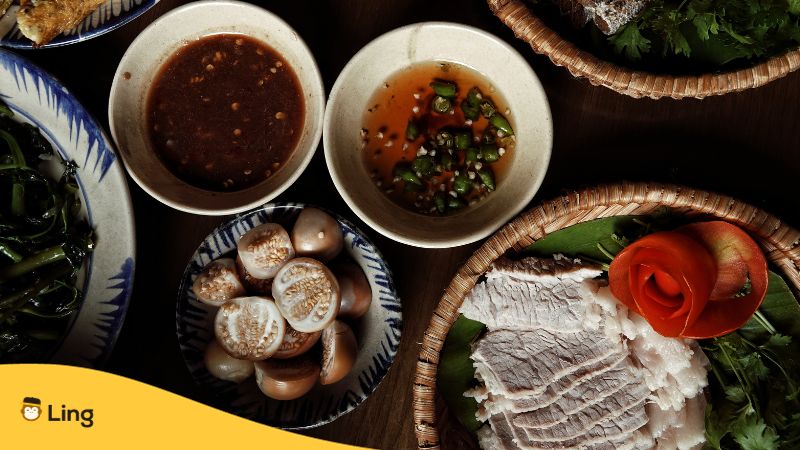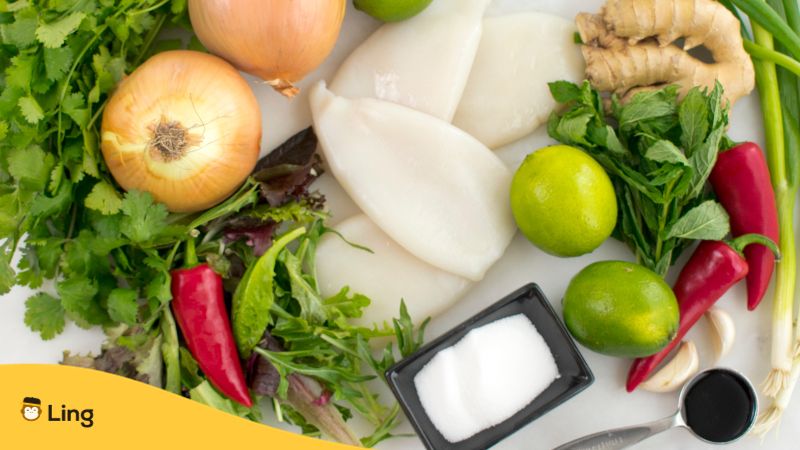Are you craving something you’ve seen on a Vietnamese menu but couldn’t remember what it’s called? It’s high time to expand your Vietnamese food ingredients vocabulary and learn the commonly used terms in Vietnamese cuisine. Whether you are planning a visit to Vietnam or simply looking to whip up some authentic dishes at home, this guide will be your trusty companion. Ready? Let’s dig in!
Basic Vietnamese Food Ingredients
Sure, you could point to a menu when ordering food, but where’s the adventure in that? Understanding Vietnamese food ingredients is like having a treasure map. It makes your dining experience more exciting while offering insights about the culture of Vietnam.
Let’s start with the core ingredients that comprise many Vietnamese dishes:

Rice (Gạo)
Vietnamese cuisine wouldn’t be complete without rice, and not just any rice, but a wide range of varieties. They use the fragrant and delicate jasmine rice, considered the national rice of Vietnam. Then there’s the sticky rice, perfect for crafting deliciously chewy treats like glutinous rice cakes (bánh chưng) or sweet rice dumplings (xôi). Each variety brings its own texture and flavor to the table.
So, why is rice such a big deal? Well, for starters, it’s not just a side dish. Whether you’re enjoying a steaming bowl of pho or savoring a rice com tam (broken rice) dish, rice takes center stage.
Fish Sauce (Nước Mắm)
Did you know that Vietnam was among the earliest producers of fish sauce, which dates back more than 2,000 years ago? Fish sauce was pivotal in Vietnam’s ancient trade, with jars of this liquid gold being exchanged for other precious goods.
Fish sauce isn’t a one-size-fits-all deal. There’s a fascinating range of fish sauces, from the budget-friendly ones to the artisanal, small-batch delights. From Nuoc Mam Phu Quoc to Nuoc Mam Nhi, each has its unique flavor profile and culinary application.
Herbs And Greens (Rau Thảo Và Rau Xanh)
Here are the commonly used herbs and greens by Vietnamese people to make their dishes delicious and flavorful:
- Basil (Rau Quế). Basil, in Vietnam, is often the spicy. You’ll find it in dishes like beef noodle soup (bún bò huế) or some aromatic pho. Its peppery, licorice-like flavor adds a kick to your meals.
- Mint (Rau Thơm). Whether it’s sprinkled on fresh spring rolls (gỏi cuốn) or infused into traditional soups, its cool, refreshing notes balance out the richness of many Vietnamese dishes.
- Cilantro (Rau Mùi). This is a staple herb in Vietnamese cuisine. Its bright, citrusy flavors pop up in Vietnamese sandwiches (bánh mì), steamed rice sheets, bò viên beef meatballs, and noodle soups, giving that unmistakable zing.
Rice Noodles
Rice noodles come in various shapes and sizes. Whether it’s the slender strands of a bun, the flat Vietnamese steamed rice vermicelli sheets (bánh hỏi), or the broad rice noodles used in pho, there’s a noodle for every occasion. Vietnamese use rice noodles star in many classic dishes, from the iconic pho to the hearty bún chả. This is why understanding the types of rice noodles used in each dish is like unlocking a secret code to culinary bliss.

Proteins And Meats
Here are the commonly used meats in many Vietnamese foods:
- Pork (Thịt Heo). Many local dishes use either pork belly (ba chỉ) or ground pork (thịt heo băm). Both pork types are typically used in grilled pork chop, noodle dishes, “bánh mì,” “bún thịt nướng,” and “bún chả.”
- Chicken (Gà). In Vietnamese cuisine, chicken breast, or “vú gà,” is often used in dishes like soups, chicken pho, salads, and stir-fries, offering a tender and mild flavor that complements other ingredients. Meanwhile, chicken thigh, or “đùi gà,” is commonly used in dishes like “cơm gà” (chicken rice) and “cao lầu” (noodle soup).
- Beef (Bò). Beef flank or “nạm bò” is preferred for broths and flank steak, while beef brisket (gầu bò) is used in whipping up “hủ tiếu” or soup and “bò kho” or beef stew.
- Seafood (Hải Sản). The most used seafood in Vietnamese cuisine, typically added to many dishes, such as fried rice, street food, salad rolls, hot broth, and more, are shrimp (tôm), squid (mực), and crabs (cua).
Vietnamese Flavor Enhancers
Vietnamese cooking won’t be complete without its vibrant and complex flavors, and the secret behind this culinary magic lies in its flavor enhancers and condiments. These ingredients add depth, aroma, and an irresistible kick to Vietnamese dishes.
Here are some of the favorite food enhancers of many Vietnamese:
| English | Vietnamese | Vietnamese Pronunciation |
| Cloves | Đinh hương | Deen hoo-uhng |
| Cardamom | Thảo quả | Taw kwah |
| Coriander Seed | Hạt ngò | Haht ngo |
| Black Pepper | Ớt tiêu đen | Oht tee-uh dehn |
| Lemongrass | Xả | Sah |
| Ginger | Gừng | Guhng |
| Garlic | Tỏi | Toy |
| Chili | Ớt | Oht |
| Tamarind | Mễ | Mey |
| Hoisin Sauce | Tương đen | Too-uhng dehn |
| Sriracha Sauce | Sriracha | See-rah-cha |
| Soy Sauce | Nước tương | Nuh-uhk too-uhng |
| Star Anise | Hoa hồi | Hwah hoo-ee |
| Cinnamon | Quế | Kwey |
Learn Vietnamese
As we learned in this article, understanding Vietnamese food ingredients vocabulary allows you to connect with Vietnamese culture, appreciate the nuances of regional variations, and create authentic dishes that capture the essence of Vietnam. From the fragrant herbs to the aromatic spices, each ingredient plays a crucial role in crafting the distinctive taste of Vietnamese dishes.
If you are ready to expand your Vietnamese food vocabulary, look no further than Ling. This application, available for download on both the App Store and Play Store, offers a fun and interactive way to master not only Vietnamese food ingredients but also the language as a whole, plus hoards of other foreign languages. By learning the language, you’ll gain a deeper insight into the culture and cuisine and find it a breeze to describe Vietnamese food. So, embrace the adventure, and let your taste buds be your guide in the flavorful world of Vietnamese cuisine. Happy cooking and learning!


































































